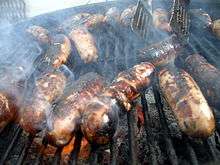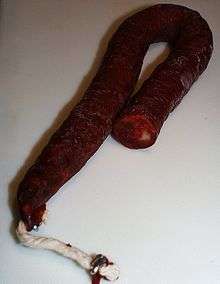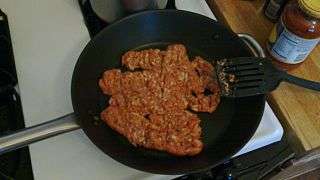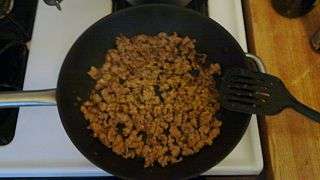Cookbook:Sausage

Cookbook | Recipes | Ingredients | Meat and poultry
| Basic foodstuffs
Summer sausage, kielbasa, bologna, bratwurst: The list goes on and on. There are so many varieties of sausage. How long can you store them -- and where? Are they fully cooked or not? The following background information will answer these questions and others.
Types of Sausages
Sausages are either ready to eat or not. They can be made from red meat, poultry or a combination. Uncooked sausages include fresh (bulk, patties or links) and smoked sausages. Uncooked smoked sausages containing pork must be treated for trichinae.
Ready-to-eat sausages are dry, semi-dry and/or cooked. Dry sausages may be smoked, unsmoked or cooked. Semi-dry sausages are usually heated in the smokehouse to fully cook the product and partially dry it.
Let the label be your guide to sausage selection and handling. It will tell you if the product must be kept refrigerated, the nutrient content and the ingredients. All ingredients in the product must be listed by weight in descending order in the ingredient statement.
In the United States, safe handling instructions are mandatory for all raw or partially cooked meat and poultry products.
Fresh Sausages

Fresh sausages are a coarse or finely comminuted meat food product prepared from one or more kinds of meat, or meat and meat byproducts. They may contain water not exceeding 3% of the total ingredients in the product. They are usually seasoned, frequently cured, and may contain binders and extenders. They must be kept refrigerated and thoroughly cooked before eating.
- Fresh Pork Sausages - May not contain pork byproducts and no more than 50% fat by weight.
- Fresh Beef Sausages - May not include beef byproducts and no more than 30% fat by weight.
- Breakfast Sausages - May contain meat and meat byproducts and no more than 50% fat by weight.
- Whole Hog Sausage - Meat from swine in such proportions as are normal to a single animal and no more than 50% fat by weight.
- Italian Sausage Products - Cured or uncured sausages containing at least 85% meat, or a combination of meat and fat, with the total fat content constituting not more than 35% of the finished product. It contains salt, pepper, fennel and/or anise and no more than 3% water. Optional ingredients permitted in Italian Sausages are spices (including paprika) and flavorings, red or green peppers, onions, garlic and parsley, sugar, dextrose and corn syrup.
Cooked and/ or Smoked Sausages
These products are made of one or more different kinds of chopped or ground meats which have been seasoned, cooked and/or smoked. Water can be no more than 10% by weight. Meat byproducts may be used. Included in this category are:
- salami
- liverwurst
- hot dogs
- bologna
- knockwurst
- bratwurst
- braunschweiger
- blood sausage
- jellied beef loaf
- thuringer-style.
Cooked Salami (not dry) is made from fresh meats which are cured, stuffed into casings and cooked in a smokehouse at high temperature. It may be air dried for a short time. It has a softer texture than dry and semi-dry sausages and must be refrigerated.
Meat Specialties
A ready-to-eat sausage product. It is made from comminuted meats that are seasoned and usually cooked or baked rather than smoked. They are usually sliced and served cold. Included in this category are:
- chopped ham loaf
- luncheon meat
- peppered loaf
- head cheese
- jellied corned beef
- ham and cheese loaf
- honey loaf
- old fashioned loaf
- olive loaf
- pickle and pimento loaf
- scrapple
- souse
- veal loaf.
Dry and Semi-Dry Sausages

Dry sausages may or may not be characterized by a bacterial fermentation. When fermented, the intentional encouragement of a lactic acid bacteria growth is useful as a meat preservative as well as producing the typical tangy flavor. The ingredients are mixed with spices and curing materials, stuffed into casings, and put through a carefully controlled, long, continuous air-drying process.
Dry sausages require more production time than other types of sausages and results in a concentrated form of meat. Medium-dry sausage is about 70% of its "green" weight when sold. Green weight is the weight of the raw article before addition of added substances or before cooking. Less-dry and fully-dried sausages range from 80% to 60% of original weight at completion.
Dry sausages include:
- chorizo (Spanish, smoked, highly spiced)
- Frizzes (similar to pepperoni but not smoked)
- pepperoni (not cooked, air dried)
- Landjäger
- Lola or Lolita and Lyons sausage (mildly seasoned pork with garlic)
- Genoa Salami (Italian, usually made from pork but may have a small amount of beef; it is moistened with wine or grape juice and seasoned with garlic)
Semi-dry sausages are usually heated in the smokehouse to fully cook the product and partially dry it. Semi-dry sausages are semi-soft sausages with good keeping qualities due to their lactic acid fermentation. "Summer Sausage" (another word for cervelat) is the general classification for mildly seasoned, smoked, semi-dry sausages like Mortadella and Lebanon bologna.
Casings
If you've ever wondered what "Lamb casing" or "Beef casing" meant, that means what animal the casing comes from. If you really want to know what a casing is, then I'll tell you: Natural casings mean, well something very unappetizing: The connective tissue lining on the intestines. You still want to eat sausages now? Nowadays, many companies use a synthetic casing, collagen actually, that is shaped to look like a natural casing.
Preparation
Sausages can be boiled, fried, or browned (usually in preparation for inclusion in another dish). It can be prepared with the casing on, or with it removed. The method of preparation fundamentally affects the taste and texture of the resulting dish.
-

Italian-style sausage, uncooked, in a skillet.
-

Italian style sausage browned and crumbled in a skillet.
Safety precautions
Because dry sausages are not cooked, people "at risk" (the elderly, very young children, pregnant women and those with weakened immune systems) might want to avoid eating them. The bacterium E. coli O157:H7 can survive the process of dry fermenting, and recently some children became ill after eating dry cured salami containing the bacteria. Also, the casing poses a sanitation problem because, in the first place, it is what makes raw meat infected with bacteria.
Sausage recipes
- Wiejska - the most popular form of Kielbasa, or Polish sausage
- Boerewors - a very popular South African sausage
- Seitan Bratwurst - a very easy and tasty vegetarian Bratwurst.